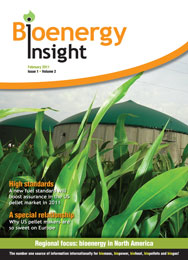
Volume 2, Issue 1
Published: February 21, 2011
EPA’s greenhouse gas tailoring rule
Register or Log In to view this "Free Article"On 12 January 2011 the US Environmental Protection Agency (EPA) announced that it will defer greenhousegas (GHG) permitting requirements for facilities using biomass to make electricity. During the threeyear...
Your questions answered
Register or Log In to view this "Free Article"QWhat is the status of co-firing biomass with coal in the US? ALittle has happened over the last year in the area of utility co-firing biomass with coal or the development of stand-alone biomass power...
Blowing hot and cold
Register or Log In to view this "Free Article"While Europe shivers and winces at its soaring energy bills, across the Atlantic energy prices are trading at historic lows. Yet this is no cause for rejoicing as the contributing factors to the low energy...
Dr Digester strikes again
The US may not be as developed as Europe when it comes to producing electricity from biomass, but it is not an industry that should be ignored. Over 70 million tonnes of food waste is generated each year...
A special relationship
It is impossible to write an article about bioenergy without keeping one eye on how old-fashioned fossil fuels are faring. At the time of writing, January 2011, natural gas prices in the US were still...
The Maine contender
In Maine there are 15 million acres of forest land. Around 50% of this is certifi ed as sustainable, and this is growing by an additional 500,000 acres a year. The state is home to four pellet producers:...
Bio-economy, a challenging pathway to sustainability
The European bioeconomy cannot compete on a global level by delivering only basic agricultural commodities. The exact definition of this concept varies. The KBBE (Knowledge- Based Bio-Economy) focus of...
Moisture management
There are two major problems with wet biomass. First of all, when fresh biomass with around 55% moisture is transported to a power plant, most of what is transported is water. Water being a relatively...
Flying high
The technique of using bacteria under anaerobic conditions to convert a wide variety of carbonbased bio-materials into methane gas has been used for decades, yet its unappealing association with the treatment...
High standards
Biomass testing is a relatively new practice in the US and one that developed through a confl uence of various factors: the emergence of international standards, the development of more sophisticated biomass...
Boilers: which to choose
Boiler design has been honed over 300 years to its current state, and alongside that the design of the furnace grate or bed has been optimised to suit different fuels. You only have to try logs in a domestic...
Making maize work
UK biogas producers should take a leaf out of their continental counterparts’ book and use maize as a highly cost-effective feed source for new energy plants. However, it has to be the right variety...
The need for characterisation
Biomass and biofuels are very heterogeneous and chemically complex materials. They are mainly carbon- hydrogen- and oxygen-based, while also containing nitrogen and sulphur. Understanding this natural...
























